Marolo
(Annona crassiflora)

Description
Annona crassiflora, commonly known as marolo, araticum cortiça, araticum do cerrado or bruto, is a flowering plant in the Annonaceae family. The flowers of a marolo look like jellyfish wearing hats, and the fruits are sweet and very rough. It is native to Brazil and Paraguay and the fruit is eaten by native peoples in the Brazilian Cerrado.Although it is considered to have potential for cultivation, it has not been domesticated to date. Marolo is a tree of about 6–8 m tall, with a crown diameter reaching 2-4 m, from the Annonaceae family, which occurs discontinuously in the Brazilian cerrado. The plant prefers the savannah regions with lower moisture deficit such as Minas Gerais, where the fruit is typical and very much appreciated, Mato Grosso do Sul, a small portion of the interior of São Paulo and in isolated parts of Goiás, Mato Grosso, Tocantins, Maranhão and the eastern part of Bahia. It has axial root system that reaches greater depths in the soil to absorb water and nutrients. Its trunk is straight with crooked twigs, its bark is corky, chipped and thick. It has ovate leaves, leathery, yellow-greenish flowers that occur between November and January, with entomophilous pollination, more specifically by the Ciclocéfalo beetle (Cyclocephala atricapilla). The fruits are multiple bacáceas infructescenses up to 4.5 kg, edible, green-brownish bark when mature, with seeds also regarded as anti-diarrheal. Annona (from Taíno annon) is a genus of flowering plants in the pawpaw/sugar apple family, Annonaceae. It is the second largest genus in the family after Guatteria, containing approximately 166 species of mostly Neotropical and Afrotropical trees and shrubs. The generic name derives from anón, a Hispaniolan Taíno word for the fruit. Paleoethnobotanical studies have dated Annona exploitation and cultivation in the Yautepec River region of Medicoto to approximately 1000 BC. Plants of the genus have several common names, including sugar-apple, soursop, and guanabana. Currently, seven Annona species and one hybrid are grown for domestic or commercial use, mostly for the edible and nutritious fruits; several others also produce edible fruits. Many of the species are used in traditional medicines for the treatment of a variety of diseases, though their efficacy has yet to be validated scientifically. Several annonacaeous species have been found to contain acetogenins, a class of natural compounds with a wide variety of biological activities.
Taxonomic tree:







